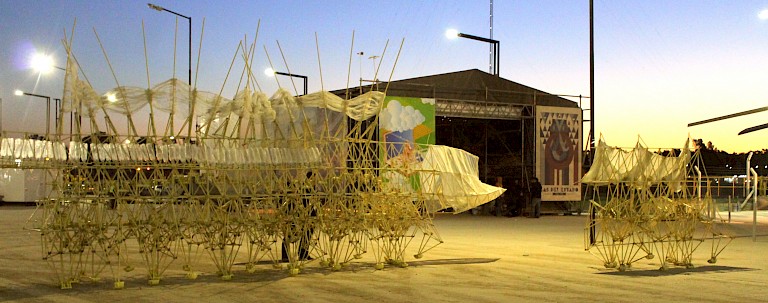



Each of Jansen’s beasts takes approximately a year to create, and each new strandbeest improves on the previous version, with the artist implementing modifications in response to the difficulties encountered (e.g. withstanding storms)—a kind of assisted evolution. One iteration of Jansen’s strandbeest projects consisted of the installation of two creatures from a growing bestiary at Tecnopolis 2012, the largest art/science/technology event in Latin America. The two animals were Animaris Umerus and Animaris Ordis Mutantis, the former, a gigantic 12-meter in length and 4-meter in height, and the latter, closer to human scale.
Originally designed for roaming beaches, the strandbeests move gracefully at times, and hesitantly at others on their multiple feet. Encountering them, it feels as though one is in the presence of a rudimentary intelligence attempting to make sense of its world, and to adapt to its climatic conditions. As far as placemaking goes, these beasts have an unquestionable ability to transform a site, generating encounters that are at once familiar and alien. They are familiar in that they recall the exploratory movements a developing infant or child makes, and insofar as they are constructed of plastic, a ubiquitous material in today’s consumer society. They are alien in that they incarnate forms that are strange or bizarre, that nevertheless share with us certain possibilities, that of movement, sensation and reaction to the environment.
Strandbeest reminds us that life is all around as well as inside us, that humans are not the only lifeform worthy of serious consideration. This reminder erodes strains of humanistic and rationalist thought, which have placed humanity erroneously at the apex of evolution, and convinced us that life and consciousness are exclusive qualities of the organic, and especially human, body. Perhaps it is not a coincidence that Jansen began making them in response to growing awareness of climate change and the rising sea levels. The beasts make us reflect on the impact of unrestrained human life on other forms of life. They make us consider the consequences of human industrialization and mass consumption on the life of the oceans and the other species with whom we share the planet. Walking on its many feet, the beasts of the beaches appear like specters from an uncertain future, in which human life has become increasingly precarious.
The project’s excellence consists of these reminders of other lives and futures, as well as the technical genius and perseverance it has taken to cultivate the strandbeests. The many self initiated projects Strandbeest has inspired around the world (people making their own strandbeests based on the principles demonstrated by Jansen’s) provides a measure of how the project has captured the imagination of communities around the world.
All copyright belongs to Shanghai Academy of Fine Arts, Shanghai University.



